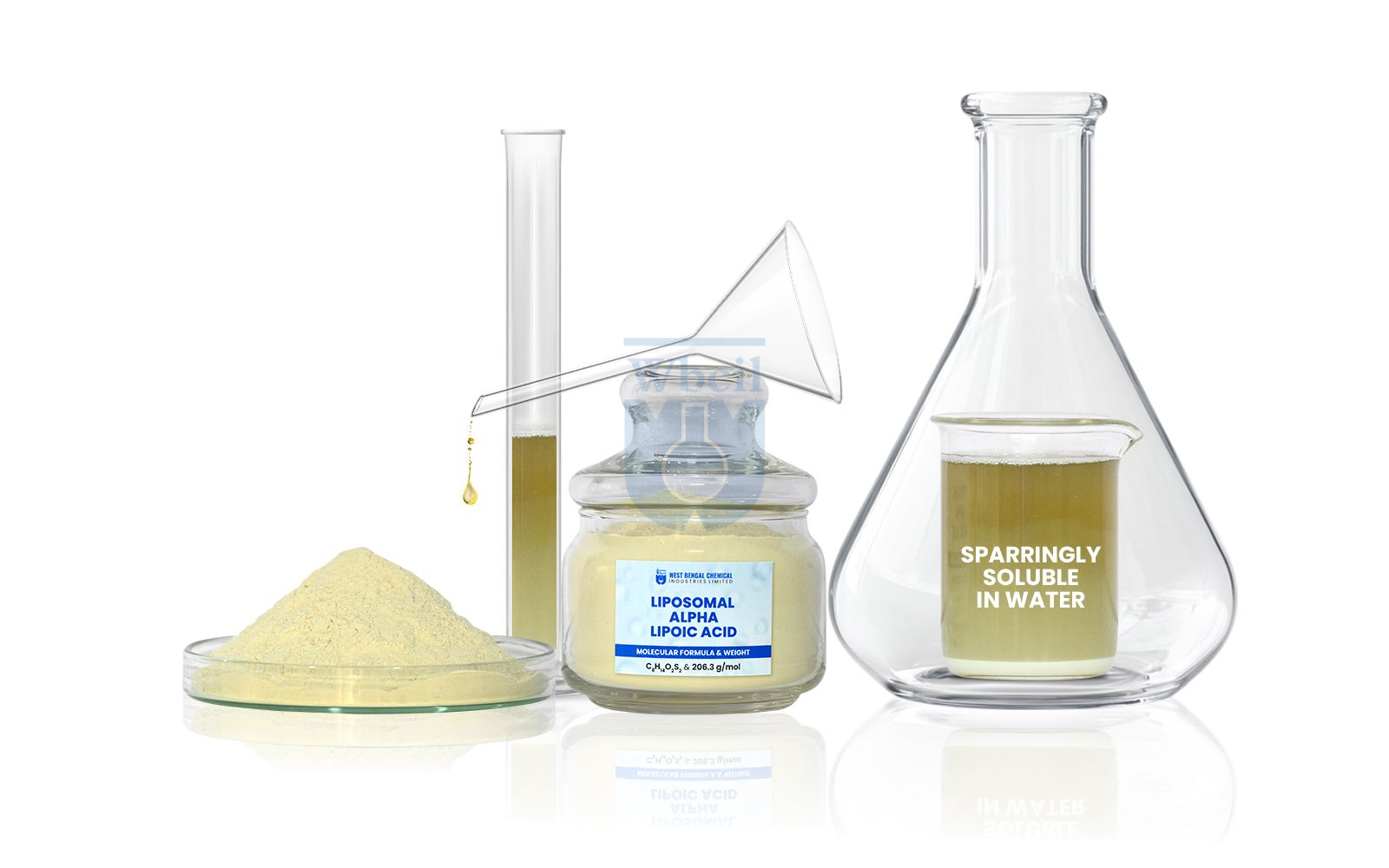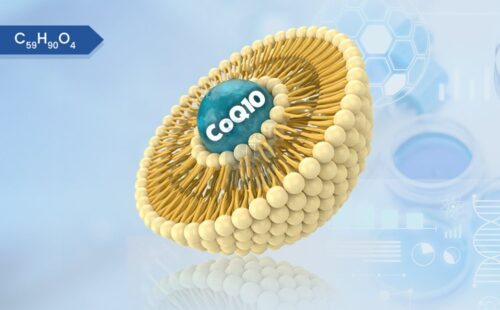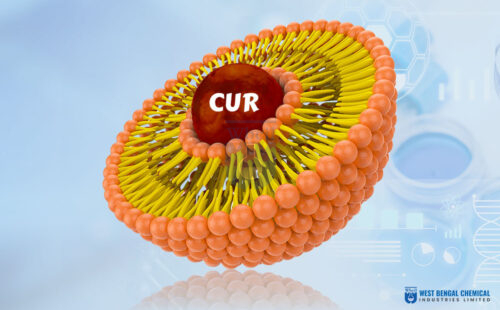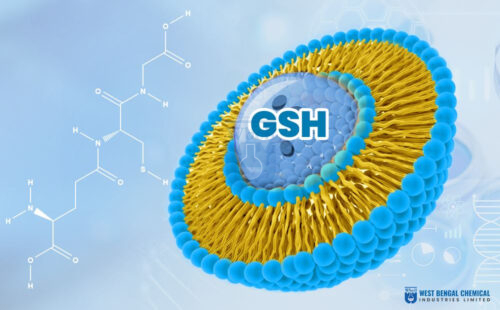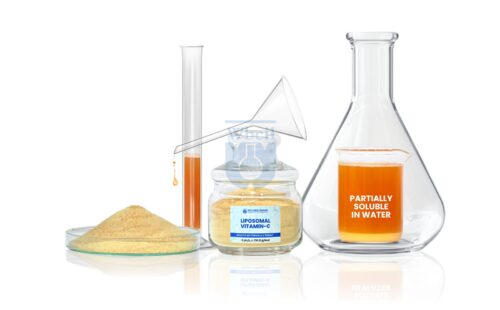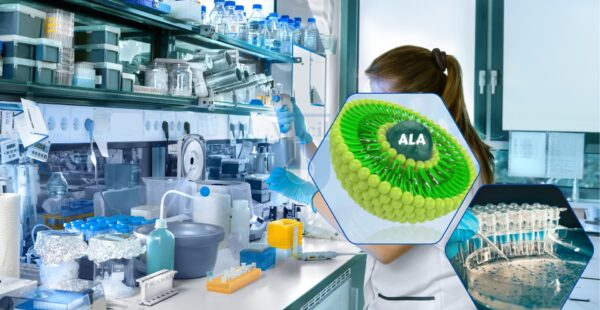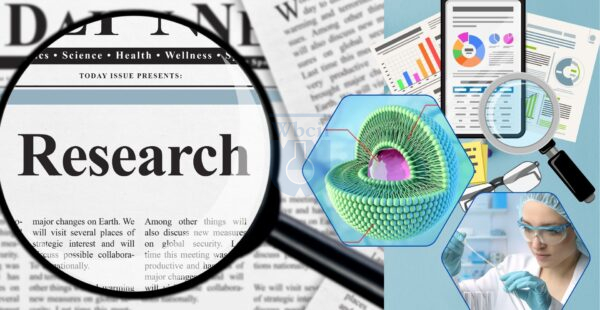-
Product Name:
Liposomal Alpha Lipoic Acid
-
Molecular Formula:
C8H14O2S2
-
Molecular Weight:
206.3 g/mol
-
CAS No.:
1200-22-2
-
HSN Code:
29309099
-
CID Code:
6112
-
Shelf Life:
3 years - 20°C powder
-
ATC Code (WHO)
A16AX01
-
DrugBank ID
DB00166
-
ChemSpider ID
5886
-
UNII No.
VLL71EBS9Z
- USP
- IUPAC Names
- Synonyms
- Insights
- MSDS
- White Paper
USP of Liposomal Alpha Lipoic Acid
- Liposomal ALA boosts ALA’s antioxidant power with better absorption.
- It merges ALA’s solubility with efficient liposomal delivery.
- The formula keeps ALA’s free radical defense strong and bioavailable.
- Liposomal ALA enhances ALA’s energy support with stability.
- It offers ALA’s cell protection in a pure liposomal form.
- The product amplifies ALA’s antioxidant recycling via improved uptake.
- Liposomal ALA maximizes ALA’s benefits with less waste.
IUPAC Names of Liposomal Alpha Lipoic Acid
- (R)-5-(1,2-Dithiolan-3-yl)pentanoic acid
- α-Lipoic acid; Alpha lipoic acid; Thioctic acid; 6,8-Dithiooctanoic acid
Synonyms of Liposomal Alpha Lipoic Acid
- Acid, alpha-Lipoic
- Alpha Lipogamma
- alpha Lipoic Acid
- Alpha-Lippon AL
- espa-lipon
- espalipon
- Injekt, Thiogamma
- Lipoic Acid
Insights Liposomal Alpha Lipoic Acid
- Appearance: off white colour free flowing powder
- Solubility: Slightly soluble in water; soluble in organic solvents like ethanol and DMSO
- Stability: Stable under recommended storage; sensitive to heat and light
- Formulation Type: API-grade powder (customizable for liposomal, tablet, or capsule applications)
- Particle Size: D90 ≤ 150 µm (customizable micronized grade available)
- pH (1% solution): 6.0 – 8.0
- Storage Temperature: <=25°C in dry place
- Storage Conditions: Store in an airtight container in a cool, dry, dark environment
- Odor: Faint sulfur-like odor
- Taste: Slightly bitter
- Packaging: HDPE drums with inner food-grade liner (5 kg, 25 kg standard)
MSDS of Liposomal Alpha Lipoic Acid
Download MSDS PDF- MSDS Name: Liposomal Alpha Lipoic Acid
- Product Code: ALALI35
- General information: Symptoms of poisoning may even occur after several hours; therefore, medical observation for at least 48 hours after the accident.
- After inhalation: In case of unconsciousness place patient stably in side position for transportation.
- After skin contact: Immediately wash with water and soap and rinse thoroughly.
- After eye contact: Rinse opened eye for several minutes under running water. If symptoms persist, consult a doctor.
- After swallowing: Immediately call a doctor.
- Most important symptoms and effects, both acute and delayed
- No further relevant information available. Indication of any immediate medical attention and special treatment needed
- No further relevant information available.
- Components with limit values that require monitoring at the workplace: Not required.
- Additional information: The lists that were valid during the creation were used as basis.
- General protective and hygienic measures: Keep away from foodstuffs, beverages and feed. Immediately remove all soiled and contaminated clothing. Wash hands before breaks and at the end of work. Avoid contact with the eyes and skin.
- Breathing equipment: In case of brief exposure or low pollution use respiratory filter device. In case of intensive or longer exposure use respiratory protective device that is independent of circulating air.
- Protection of hands: The glove material has to be impermeable and resistant to the product/ the substance/ the preparation. Due to missing tests no recommendation to the glove material can be given for the product/ the preparation/ the chemical mixture. Selection of the glove material on consideration of the penetration times, rates of diffusion and the degradation.
- Material of gloves: The selection of the suitable gloves does not only depend on the material, but also on further marks of quality and varies from manufacturer to manufacturer.
- Penetration time of glove material: The exact break through time has to be found out by the manufacturer of the protective gloves and has to be observed.
- Eye protection: Tightly Sealed Goggles
- Appearance Form: Free flowing powder
- Color: Off white
- Odour: NA
- Solubility: NA

Description of Liposomal Alpha Lipoic Acid
Liposomal alpha-lipoic acid (ALA) API (active pharmaceutical ingredient) is a specialized formulation where alpha-lipoic acid, a naturally occurring organosulfur compound, is encapsulated within phospholipid-based liposomes to serve as a raw material for pharmaceutical or nutraceutical products.
Chemically, ALA (C₈H₁₄O₂S₂, 1,2-dithiolane-3-pentanoic acid) is a chiral molecule with a five-membered disulfide ring, exhibiting amphiphilic properties due to its ability to dissolve in both aqueous and lipid environments, though its stability is sensitive to heat and oxidation. The liposomal encapsulation, typically utilizing phosphatidylcholine, forms a dry or semi-dry powder or granular matrix, enhancing ALA’s resistance to degradation.
Physically, this API appears as a pale yellow to off-white powder, with a faint sulfurous odor characteristic of ALA’s thioctic structure, and its fine texture reflects the microscale liposomal vesicles. The liposomal coating improves ALA’s dispersibility and protects its reactive disulfide bond, making it a robust ingredient for downstream formulation into supplements or therapeutics. As a leading API manufacturer, WBCIL prioritizes strict CGMP and ISO quality control measures throughout the production process. The prolonged experience from 1962 ensures consistent potency, purity, and safety in every dose of WBCIL’s liposomal alpha lipoic acid.
Key Benefits of Liposomal Alpha Lipoic Acid
- Dual-Solubility Antioxidant – Functions in both lipid and aqueous environments for broad cellular protection
- Supports Glucose Metabolism – Enhances insulin sensitivity and blood sugar regulation
- Neuroprotective Action – Reduces oxidative stress in nerves, beneficial in diabetic neuropathy and neurodegenerative disorders
- Liver Detox & Mitochondrial Health – Promotes detoxification and energy metabolism at the cellular level
- Combats Inflammation & Aging – Inhibits inflammatory cytokines and supports anti-aging pathways
- Chelates Heavy Metals – Binds and removes excess metals like mercury and arsenic from the body
- Improved Skin Clarity & Elasticity – Emerging use in cosmeceuticals for its anti-aging and collagen-supportive properties
- Ideal for Chronic Illness Recovery – Especially useful in diabetes, cardiovascular disease, and oxidative stress conditions
- Synergistic with Other Nutrients – Regenerates other antioxidants like Vitamin C, E, and CoQ10
- Formulation Flexibility – Compatible with capsules, powders, injectables, and liposomal delivery formats
Uses of Liposomal Alpha Lipoic Acid
Alpha Lipoic Acid is a recognized API in:
- Diabetic Neuropathy Treatments
- Adjunct Therapy in Metabolic Syndrome
- Neurodegenerative Disease Management – Parkinson’s, Alzheimer’s
- Cardiovascular Health Supplements
- Detox & Liver Health Formulations
- Preferred in oral, IV, and topical dosage forms. WBCIL supports formulation customization.
- Energy Metabolism & Weight Management
- Blood Sugar Support Supplements
- Anti-aging Antioxidant Formulas
- Sports Nutrition & Muscle Recovery
- Skin Glow & Repair Gummies
- Ideal for capsule, powder, effervescent, or liposomal product lines.
- Pet Supplements for Joint & Brain Health
- Livestock Feed Additive for Immune Function
- Oxidative Stress Reduction in High-Performance Animals
- We offer bulk supply of feed-grade and veterinary-compatible ALA with regulatory compliance
- Cosmeceuticals & Skincare: Creams, serums, anti-aging lotions
- Topical Pain Relief Formulas
- Research & Biotech Uses: Oxidative stress studies, drug carriers
WBCIL offers pharma-grade Alpha Lipoic Acid with >99% purity, manufactured under WHO-GMP and ISO-certified facilities. It is optimized for stability, bioavailability, and is available in multiple grades tailored for both pharma and nutraceutical formulations.
Yes, ALA is widely used as an adjunct in diabetic neuropathy due to its antioxidant and insulin-sensitizing properties. WBCIL supplies ALA suitable for such formulations in compliance with global pharmacopeial standards.
The typical supplemental dose of ALA ranges from 300–600 mg per day for adults, depending on the intended use. Formulators should consult regional regulations and scientific guidance for precise dosage.
Yes, WBCIL’s ALA is synthetically derived and free from animal-origin ingredients, making it suitable for both vegetarian and vegan products.
ALA is generally well-tolerated but may cause mild symptoms like nausea or skin rash at higher doses. It may interact with anti-diabetic medications, so medical supervision is advised for therapeutic use.
WBCIL’s Alpha Lipoic Acid has a shelf life of 24–36 months when stored in a cool, dry place away from light and heat. It is supplied in moisture-protective packaging to preserve stability.
Yes, WBCIL can provide a Drug Master File (DMF) or equivalent regulatory documentation for clients requiring submission support.
WBCIL offers custom solutions, including liposomal and sustained-release-ready ALA APIs, developed to meet specialized delivery and formulation needs.
Yes, Alpha Lipoic Acid is approved for use in nutraceuticals by FSSAI and is permitted under the USFDA’s dietary ingredient framework. Our material meets all quality and compliance parameters for these markets.
Absolutely — WBCIL supports global B2B partners with flexible minimum order quantities, custom assay/specification options, and scalable volumes to suit both emerging and established brands.










